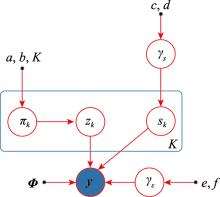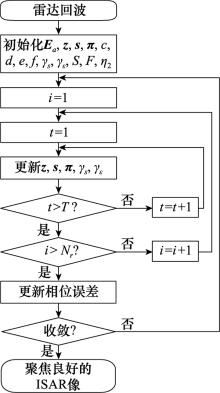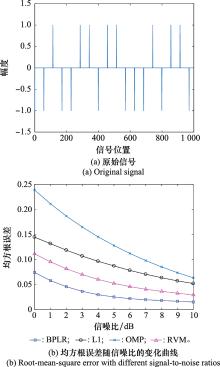| 1 |
CZERWINSKI M G , USOFF J M . Development of the haystack ultrawideband satellite imaging radar[J]. Lincoln Laboratory Journal, 2014, 21 (1): 28- 44.
|
| 2 |
SNYDER D L . High resolution radar imaging[M]. Dedham, MA: Artech House, 1981.
|
| 3 |
CHEN C C , ANDREWS H C . Target-motion-induced radar ima-ging[J]. IEEE Trans.on Aerospace and Electronic Systems, 1980, 16 (1): 2- 14.
|
| 4 |
HERMAN M A , STROHMER T . High-resolution radar via compressed sensing[J]. IEEE Trans.on Signal Processing, 2009, 57 (6): 2275- 2284.
doi: 10.1109/TSP.2009.2014277
|
| 5 |
POTTER L C , ERTIN E , PARKER J T , et al. Sparsity and compressed sensing in radar imaging[J]. Proceedings of the IEEE, 2010, 98 (6): 1006- 1020.
doi: 10.1109/JPROC.2009.2037526
|
| 6 |
ENDER J H . On compressive sensing applied to radar[J]. Signal Processing, 2010, 90 (5): 1402- 1414.
doi: 10.1016/j.sigpro.2009.11.009
|
| 7 |
ZHANG L , XING M D , QIU C W , et al. Resolution enhancement for inversed synthetic aperture radar imaging under low SNR via improved compressive sensing[J]. IEEE Trans.on Geoscience and Remote Sensing, 2010, 48 (10): 3824- 3838.
doi: 10.1109/TGRS.2010.2048575
|
| 8 |
ZHAO L F , WANG L , YANG L , et al. The race to improve radar imagery: an overview of recent progress in statistical sparsity-based techniques[J]. IEEE Signal Processing Magazine, 2016, 33 (6): 85- 102.
doi: 10.1109/MSP.2016.2573847
|
| 9 |
MALLET S G , ZHANG Z . Matching pursuits with-frequency dictionaries[J]. IEEE Trans.on Signal Processing, 1993, 41 (12): 3397- 3415.
doi: 10.1109/78.258082
|
| 10 |
PATI Y C, REZAIIFAR R, KRISHNAPRASAD P S. Orthogonal matching pursuit: recursive function approximation with applications to wavelet decomposition[C]//Proc. of the 27th Asilomar Conference on Signals, System, Computation, 1993: 40-44.
|
| 11 |
DONOHO D L, ELAD M. Optimally sparse representation in general (nonorthogonal) dictionaries via l1 minimization[C]//Proc. of the National Academy of Sciences, 2003: 2197-2202.
|
| 12 |
DONOHO D L , ELAD M , TEMLYAKOV V N . Stable recovery of sparse overcomplete representations in the presence of noise[J]. IEEE Trans.on Information Theory, 2006, 52 (1): 6- 18.
doi: 10.1109/TIT.2005.860430
|
| 13 |
WU Y L , ZHANG S S , KANG H Q , et al. Fast marginalized sparse Bayesian learning for 3-D interferometric ISAR image formation via super-resolution ISAR imaging[J]. IEEE Journal of Selected Topics in Applied Earth Observations and Remote Sensing, 2015, 8 (10): 4942- 4951.
doi: 10.1109/JSTARS.2015.2455508
|
| 14 |
XU G , YANG L , BI G A , et al. Enhanced ISAR imaging and motion estimation with parametric and dynamic sparse Bayesian learning[J]. IEEE Trans.on Computational Imaging, 2017, 3 (4): 940- 952.
doi: 10.1109/TCI.2017.2750330
|
| 15 |
BABACAN S D , MOLINA R , KATSAGGELOS A K . Baye-sian compressive sensing using Laplace priors[J]. IEEE Trans.on Image Processing, 2010, 19 (1): 53- 63.
doi: 10.1109/TIP.2009.2032894
|
| 16 |
TIPPING M E . Sparse Bayesian learning and the relevance vector machine[J]. Journal of Machine Learning Research, 2001, 1 (1): 211- 244.
|
| 17 |
BISHOP C M, TIPPING M E. Variational relevance vector machines[C]//Proc. of the 16th Conference Uncertainty Artificial Intelligence, 2000: 46-53.
|
| 18 |
PERRY R P , DIPIETRO R C , FANTE R L . SAR imaging of moving targets[J]. IEEE Trans.on Aerospace and Electronic Systems, 1999, 35 (1): 188- 199.
doi: 10.1109/7.745691
|
| 19 |
BAI X R , ZHOU F , WANG Q , et al. Sparse subband imaging of space targets in high-speed motion[J]. IEEE Trans.on Geoscience and Remote Sensing, 2013, 51 (7): 4144- 4154.
doi: 10.1109/TGRS.2012.2227756
|
| 20 |
PAISLEY J, CARIN L. Nonparametric factor analysis with Beta process priors[C]//Proc. of the International Conference on Machine Learning, 2009.
|
| 21 |
CHEN B, PAISLEY J, CARIN L. Sparse linear regression with Beta process priors[C]//Proc. of the IEEE International Conference on Acoustics Speech & Signal Processing, 2010: 14-19.
|
| 22 |
张毓. 基于非参数贝叶斯的ISAR稀疏成像研究[D]. 西安: 西安电子科技大学, 2020.
|
|
ZHANG Y. Study on sparse ISAR imaging based on Bayesian nonparametrics[D]. Xi'an: Xidian University, 2020.
|









